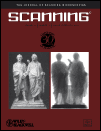Advanced Cantilevers for Magnetic Force Microscopy and High Frequency Magnetic Force Microscopy
Abstract
In order to improve the spatial resolution achieved by magnetic force microscopy (MFM) technique and its derivatives, we employ here advanced MFM tips fabricated by means of focused ion beam (FIB) milling. The magnetic coating applied on these tips is a CoCr film of 10 nm thickness. The MFM measurements on hard disk test samples reveal the achieved high resolution, and the measurement on a garnet film demonstrates the low invasiveness. High-frequency MFM (HF-MFM) is a development of the MFM technique to observe the HF stray fields emerging from magnetic recording writer poles at their operating conditions. By means of HF-MFM, magnetic recording writer poles are characterized in the frequency range 100–1,000 MHz. Up to now, all HF-MFM experiments conducted were using standard MFM cantilevers. From the HF-MFM images obtained using the advanced MFM cantilevers, it is clearly seen that the spatial resolution is considerably improved over the images obtained using standard MFM tips. However, the 10 nm thick magnetic coating of the cantilevers is found to work properly only at frequencies of up to about 500 MHz. SCANNING 30: 27–34, 2008. © 2008 Wiley Periodicals, Inc.




